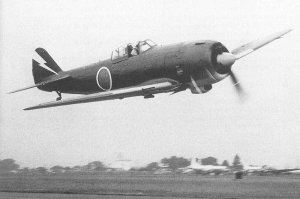![]() The Pacific War Online Encyclopedia
The Pacific War Online Encyclopedia
|
| Previous: Ki-79, Japanese Trainer | Table of Contents | Next: Ki-100 "Tony", Japanese Fighter |

Nakajima Ki-84-1a Hayate ("Gail") “Frank”
| Dimensions | 36’11”
by 32’7”
by
11’1” 11.25m by 9.93m by 3.38m |
|||
| Weights | 5864-8267 lbs 2660-3750 kg |
|||
| Wing area | 226 square feet 21.0 square meters |
|||
| Maximum speed | 392 mph at 20,800
feet 631 km/h at 6340 meters |
|||
| Cruise speed | 277 mph 446 km/h |
|||
| Climb rate | 46 feet per second 14.0 meters per second |
|||
| Service ceiling | 34,450 feet 10,500 meters |
|||
| Power plant | 1 1900 hp (1417 kW) Nakajima Homare HA45 Model 11 18-cylinder 2-row radial engine driving a constant speed four bladed metal propeller. | |||
| Armament | 2 20mm Ho-5
cannon
with 150 rounds each in wings 2 12.7mm Type 1 machine guns with 350 rounds each in top of fuselage |
|||
| External stores |
Two 250kg (550 lb) bombs or two 44 gallon (167 liter) drop tanks | |||
| Fuel |
157.1
gallons (595 liters) internal |
|||
| Range | 1053 miles (1690 km) normal 1815 miles (2920 km) with drop tanks |
|||
| Production | Total of 3514 Ki-84 as follows: | |||
| Nakajima Hikoki K.K. at Ota and Utsonomiya: | ||||
| 127 | Ki-84 pre-production Ki-84 (1943-3 to 1944-6) | |||
| 3288 | Ki-84-I and -II (1944-4 to 1945-8) | |||
| Mansyu Hikoki Seizo K.K. at Harbin: | ||||
| 94 | Ki-84-I (1945) | |||
| 1 | Ki-116 prototype (1945) | |||
| Tachikawa Hikoki K.K. at Tachikawa | ||||
| 3 | Ki-106 prototypes (1945) | |||
| Variants |
The 1b replaced
the
12.7mm with 20mm cannon. The 1c replaced the 20mm wing cannon
with 30mm
Ho-105
cannon. The II was partially built of wood due to the shortage of metal alloys. |
|||
The Ki-84 Hayate (Gale), known to the Allies as "Frank", was probably the best Japanese fighter to enter production. However, by the time "Frank" went into production, quality control was so poor that the aircraft coming out of the factory were barely serviceable. In particular, there was a tendency for the landing gear, which were poorly heat-treated, to fold up. There were also persistent problems with the fuel injection system. But those that worked and were piloted well could sometimes outfly a Mustang.
The design dated to early 1942, when the Army
called for a new fighter to replace the Ki-43
"Oscar". This was a matter of foresightedness rather than
any
disappointment with "Oscar". The new fighter was to have a long
range,
high speed, and improved armament and armor
protection. The design team, led by Koyama T., completed a
prototype by
March 1943 and this proved to have unusually few bugs. Service
trials
production began in August 1943 and quantity production began in
April
1944.
Unlike most Japanese fighters, "Frank" was
properly armed and protected. The basic "Zero" pattern of cannon in
the
wings and machine guns in the nose cowling was retained in the Ia,
but
the cannon were higher velocity with a much larger ammunition
loadout
and the machine guns were heavy rather than rifle caliber. The Ib
and
Ic had
powerful all-cannon armament.
The first operational use of "Frank" was with 22 Air Brigade in China in March 1944, where it operated against Chennault's 14 Air Force. The new fighter must have come as something of a rude shock to the American flyers, given the satisfaction with which the Japanese regarded the performance of the experimental unit. "Frank" subsequently flew in the Philippines, at Okinawa, and in the final defense of Japan. So great was the Japanese faith in the design that, at the time of the surrender, underground factories were being built to produce "Frank" at the rate of 200 per month.
The American command
took the threat posed by "Frank" seriously enough to designate the
Ota assembly plant as a priority target for strategic bombing on
11 November 1944.
 |
Website with
very complete photography of museum specimen
References
Craven and Cate (1952; accessed 2014-12-13)
The Pacific War Online Encyclopedia © 2007, 2009-2010, 2014 by Kent G. Budge. Index